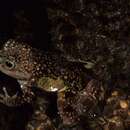Description
provided by AmphibiaWeb articles
Adults up to 100-120 mm, one calling male from Tsaratanana 96 mm. Tibiotarsal articulation can reach the nostril. Hand without webbing, foot completely webbed. Terminal discs of fingers and toes somewhat enlarged. Dorsal skin very granular. Colour dorsally brown with usually indistinct lighter or darker spots and markings. Venter whitish. Males with very distinct femoral glands (small but well visible in females), and a slightly distensible, probably single subgular vocal sac. Similar species: Besides the two other species in this subgenus, a confusion is also possible with Boehmantis microtympanum (which has a smooth skin and enlarged discs of fingers and toes). Juveniles can be mistaken with species in the subgenus Brygoomantis, especially with Mantidactylus biporus and similar species.Taken with permission from Glaw and Vences (2007).
Andreone, F. and Raxworthy, C. (2008). Mantidactylus guttulatus. In: IUCN 2008. 2008 IUCN Red List of Threatened Species. www.iucnredlist.org. Downloaded on 29 April 2009.
- author
- Miguel Vences
- author
- Frank Glaw
Distribution and Habitat
provided by AmphibiaWeb articles
Andavaka, Anjanaharibe, Tsaratanana (Antsahamanara, Antsahamanintsy), Benavony, Besariaka, Marojejy. It occurs between 200-1,000m asl in streams of pristine rainforest (Andreone and Raxworthy 2008).
- author
- Miguel Vences
- author
- Frank Glaw
Life History, Abundance, Activity, and Special Behaviors
provided by AmphibiaWeb articles
Habits: Found along small and medium-sized rainforest streams, usually at deep and slow-flowing stretches. Calling males do not aggregate in choruses but may occupy specific territories. During the day and when disturbed, specimens retreat into deep burrows under overhanging slopes at the stream edges. Calls: A loud and short, guttural, pulsed note, repeated after long and irregular intervals.
- author
- Miguel Vences
- author
- Frank Glaw
Life History, Abundance, Activity, and Special Behaviors
provided by AmphibiaWeb articles
It occurs in many protected areas (Andreone and Raxworthy 2008).
- author
- Miguel Vences
- author
- Frank Glaw
Mantidactylus guttulatus: Brief Summary
provided by wikipedia EN
Mantidactylus guttulatus is a species of frog in the family Mantellidae. It is endemic to Madagascar.
Its natural habitats are subtropical or tropical moist lowland forests and rivers. It is not considered threatened by the IUCN.
- license
- cc-by-sa-3.0
- copyright
- Wikipedia authors and editors

